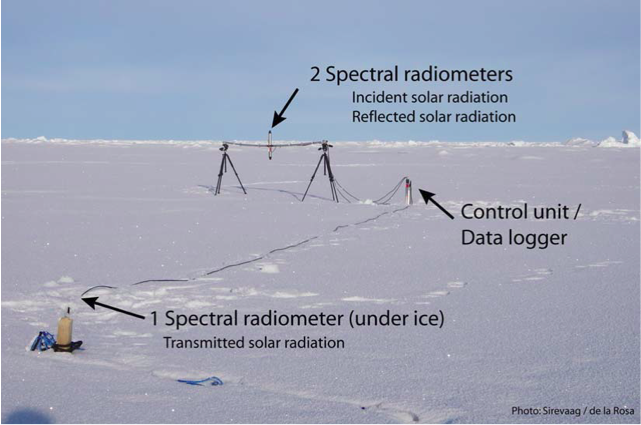Anders Sirevaag
Spectrally resolved short-wave radiation was measured at the ocean site of the ice floe; downwelling from the atmosphere, reflected by the surface, and under the ice transmitted through the snow and ice.
Download data
Visit web site
Citation
Anders Sirevaag (2018) Short-wave radiation measurements at the ocean site from the high-Arctic ASCOS expedition 2008. Dataset version 1. Bolin Centre Database. https://doi.org/10.17043/oden-ascos-2008-short-wave-1
References
Tjernström, M. et al. 2014. The Arctic Summer Cloud Ocean Study (ASCOS): overview and experimental design. Atmospheric Chemistry and Physics, 14, 2823–2869. https://doi.org/10.5194/acp-14-2823-2014
Data description
This is the spectral radiation data obtained close to the ocean site. Measurements were made of incoming and reflected visible light as well as visible light transmitted through the ice. More information is found in the attached data report.
Update: Radiation data has been reprocessed, including shadow corrections. See more information and data in file attachments
Further questions:
Marcel Nicolaus ([javascript protected email address])
Norwegian Polar Institute
Comments
At the ocean site, spectrally resolved short-wave radiation was measured, downwelling from the atmosphere, reflected by the surface, and also transmitted through the snow and ice, under the ice. These measurements started on 15 August. Transmissivity was measured until 31 August while the albedo measurements lasted until 1 September.
The spectrally resolved radiation was measured with TriOS (Oldenburg, Germany) Ramses ACC-2 VIS hyperspectral radiometers with a sensor-specific wavelength range from approx. 320 to 950 nm with an average spectral resolution of 3.3 nm (191 channels). The data was then interpolated to a 1-nm grid between 330 and 920 nm, accounting for reduced data quality at the edges of the spectra.
The albedo set up consisted of one upward-looking (incident radiation) and one downward-looking (reflected radiation) sensor. The downward-looking sensor was a pure radiometer (sensor type: SAM) while the upward-looking sensor included additional inclination and pressure sensors (sensor type: SAMIP). The downward-looking sensor was approx. 1 m above the snow surface. During installation and maintenance, interfering with the snow surface under the sensors was avoided as far as possible. The initial snow thickness was 0.1 m and the ice freeboard was 0.05 m.
The under-ice sensor (sensor type SAMIP) was located approx. 10 m from the main rack. The sensor was mounted upward-looking (transmitted radiation) in a 13-cm diameter metal frame and deployed through a 20-cm diameter bore hole. After deployment, the surface around the sensor was restored as well as possible, while the borehole re-froze with time. At the beginning of the observations ice thickness was 1.54 m and the sensor was hanging upward-looking approx. 1.0 m under the ice bottom (2.5 m under the water level). Pressure, proportional to depth in water, and inclination were measured, since they could not be observed from the surface.
Original address: http://www.ascos.se/index.php?q=node/293
Files:
ASCOS_Radiation_OceanSite_0.zip (49.55 MB)
